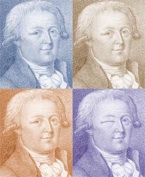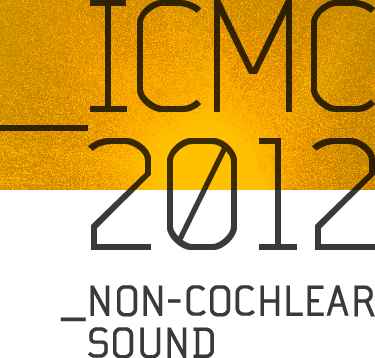» By Joren on Friday 31 August 2012
 What follows is about the Conference on Interdisciplinary Musicology (CIM2012) and the 15th international Conference of the Gesellschaft fur Musikfoschung. First this text will give information about our contribution to CIM2012: Revealing and Listening to Scales From the Past; Tone Scale Analysis of Archived Central-African Music Using Computational Means and then a number of highlights of the conference follow. The joint conference took place from the 4th to the 8th of september 2012.
What follows is about the Conference on Interdisciplinary Musicology (CIM2012) and the 15th international Conference of the Gesellschaft fur Musikfoschung. First this text will give information about our contribution to CIM2012: Revealing and Listening to Scales From the Past; Tone Scale Analysis of Archived Central-African Music Using Computational Means and then a number of highlights of the conference follow. The joint conference took place from the 4th to the 8th of september 2012.
In 2012, CIM will tackle the subject of History. Hosted by the University of Göttingen, whose one time music director Johann Nikolaus Forkel is widely regarded as one of the founders of modern music historiography, CIM12 aims to promote collaborations that provoke and explore new methods and methodologies for establishing, evaluating, preserving and communicating knowledge of music and musical practices of past societies and the factors implicated in both the preservation and transformation of such practices over time.
### Revealing and Listening to Scales From the Past; Tone Scale Analysis of Archived Central-African Music Using Computational Means
Our contribution ton CIM 2012 is titled “Revealing and Listening to Scales From the Past; Tone Scale Analysis of Archived Central-African Music Using Computational Means”:[CIM12_Submission.pdf]. The aim was to show how tone scales of the past, e.g. organ tuning, can be extracted and sonified. During the demo special attention was given to historic Central African tuning systems. The presentation I gave is included below and or available for “download”:[2012.09.05-Revealing_and_listening_to_scales_from_the_past__tone_scale_analysis_of_archived_Central-African_music_using_computational_means..ppt]
Highlights
What follows are some personal highlights for the Conference on Interdisciplinary Musicology (CIM2012) and the 15th international Conference of the Gesellschaft fur Musikfoschung. The joint conference took place from the 4th to the 8th of september 2012.
The work presented by Rytis Ambrazevicius et al. Modal changes in traditional Lithuanian singing: Diachronic aspect has a lot in common with our research, it was interesting to see their approach. Another highlight of the conference was the whole session organized by Klaus-Peter Brenner around Mbira music.
Rainer Polak gave a talk titled ‘Swing, Groove and Metre. Asymmetric Feels, Metric Ambiguity and Metric Transformation in African Musics’. He showed how research about rhythm in jazz research, music theory and empirical musicology ( amongst others) could be bridged and applied to ethnic music.
The overview Eleanore Selfridge-Field gave during her talk Between an Analogue Past and a Digital Future: The Evolving Digital Present was refreshing. She had a really clear view on all the different ways musicology and digital media can benifit from each-other.
From the concert programme I found two especially interesting: the lecture-performance by Margarete Maierhofer-Lischka and Frauke Aulbert of Lotofagos, a piece by Beat Furrer and Burdocks composed and performed by Christian Wolff and a bunch of enthusiastic students.
 Research papers, Music Information Retrieval, featured, Computational musicology, Presentation, Tarsos, and HoGent
Research papers, Music Information Retrieval, featured, Computational musicology, Presentation, Tarsos, and HoGent
 2012.09.05-Revealing_and_listening_to_scales_from_the_past__tone_scale_analysis_of_archived_Central-African_music_using_computational_means..ppt, CIM12_Submission.pdf, and Forkeljpg.jpg
2012.09.05-Revealing_and_listening_to_scales_from_the_past__tone_scale_analysis_of_archived_Central-African_music_using_computational_means..ppt, CIM12_Submission.pdf, and Forkeljpg.jpg
» By Joren on Friday 31 August 2012
 At this years ICMC Conference, ICMC 2012 we presented a paper describing a way to experiment with tone scales and how to use Tarsos as a compositional tool. What follows are some pointers to the presentation, paper and to other interesting talks that were presented there.
At this years ICMC Conference, ICMC 2012 we presented a paper describing a way to experiment with tone scales and how to use Tarsos as a compositional tool. What follows are some pointers to the presentation, paper and to other interesting talks that were presented there.
ICMC 2012 was organized in Ljubljana from the 9 to 14 septembre and had a very dense program of talks, posters, presentations, demos and concerts.
Since 1974 the International Computer Music Conference has been the major international forum for the presentation of the full range of outcomes from technical and musical research, both musical and theoretical, related to the use of computers in music. This annual conference regularly travels the globe, with recent conferences in the Americas, Europe and Asia. This year we welcome the conference to Slovenia for the first time.
### Sound to Scale to Sound, a Setup for Microtonal Exploration and Composition
Our contribution to the conference was a paper titled “Sound to Scale to Sound, a Setup for Microtonal Exploration and Composition”:[icmc2012_submission_45.pdf].
If you want to cite our work, this BibTeX entry is included for your convenience:
```ruby\
\@inproceedings{cornelis2012sound_to_scale,\
author = {Olmo Cornelis and Joren Six},\
title = {{Sound to Scale to Sound, a Setup for Microtonal Exploration and Composition}},\
booktitle = {{Proceedings of the 2012 International Computer Music Conference,\
(ICMC 2012)}},\
year = {2012},\
publisher = {The International Computer Music Association}\
}\
```
Program highlights
What follows are a number of pointers to my personal program highlights.
Verena Thomas presented two very well polished software tools. One to detect patterns in scores, called motifviewer and a tool to search in score databases in a multi-modal way. The Probado tool does score-to-audio alignment and much more.
Gibber is an impressive live-coding environment with an easy syntax. Since it is all done with javascript you can start playing with it immediately. Overtone Another live-coding environment, presented at the conference by Sam Aaron, was equally impressive. It is programmed using the Closure language.
At ICMC there were a number of tools to assist in composition. One of those is The Bach Project, by Andrea Agostini. Togheter with CatART by Diemo Swartz it forms a very expressive platform to work with sound, which was demonstrated by Aaron Einbond and Christopher Trapani in their paper titled Precise Pitch Control In Real Time Corpus-Based Concatenative Synthesis. Diemo Swartz presented work on Audio Mosaicing, it can be seen as a follow-up to AuidioGuild by Ben Hackbarth.
I also got to know the work by Thomas Grill, on his website a nice piece of software can be found a Python implementation of the Non Stationary Gabor Transform (NSGT). Another software system I got to know is the functional signal processing programming language FAUST
My personal highlights of the concert programme include the works by Johannes Kreidler, Aura Pon, Daniel Mayer, Alexander Schubert and the remarkable performance by Dexter Ford. The concept behind Soundlog by Johannes Kretz was also interesting.
 Computational ethnomusicology, Java, featured, Presentation, Tarsos, and HoGent
Computational ethnomusicology, Java, featured, Presentation, Tarsos, and HoGent
 icmc2012_submission_45.pdf, 2012.09.08-Sound_to_Scale_to_Sound__a_Setup_for_Microtonal_Exploration_and_Composition.odp, and ICMC_Logo.png
icmc2012_submission_45.pdf, 2012.09.08-Sound_to_Scale_to_Sound__a_Setup_for_Microtonal_Exploration_and_Composition.odp, and ICMC_Logo.png
 What follows is about the Conference on Interdisciplinary Musicology (CIM2012) and the 15th international Conference of the Gesellschaft fur Musikfoschung. First this text will give information about our contribution to CIM2012: Revealing and Listening to Scales From the Past; Tone Scale Analysis of Archived Central-African Music Using Computational Means and then a number of highlights of the conference follow. The joint conference took place from the 4th to the 8th of september 2012.
What follows is about the Conference on Interdisciplinary Musicology (CIM2012) and the 15th international Conference of the Gesellschaft fur Musikfoschung. First this text will give information about our contribution to CIM2012: Revealing and Listening to Scales From the Past; Tone Scale Analysis of Archived Central-African Music Using Computational Means and then a number of highlights of the conference follow. The joint conference took place from the 4th to the 8th of september 2012.
 At this years ICMC Conference,
At this years ICMC Conference,